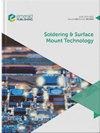Effect of different soldering temperatures on the properties of COB light source
IF 1.7
4区 材料科学
Q3 ENGINEERING, ELECTRICAL & ELECTRONIC
引用次数: 1
Abstract
Purpose The purpose of this paper is to investigate the effect of different soldering temperatures on the performance of chip-on-board (COB) light sources during vacuum reflow soldering. Design/methodology/approach First, the influence of the void ratio of the COB light source on the steady-state voltage, luminous flux, luminous efficiency and junction temperature has been explored at soldering temperatures of 250°C, 260°C, 270°C, 280°C and 290°C. The COB chip has also been tested for practical application and aging. Findings The results show that when the soldering temperature is 270°C, the void ratio of the soldering layer is only 5.1%, the junction temperature of the chip is only 76.52°C, and the luminous flux and luminous efficiency are the highest, and it has been observed that the luminous efficiency and average junction temperature of the chip are 107 lm/W and 72.3°C, respectively, which meets the requirements of street lights. After aging for 1,080 h, the light attenuation is 84.64% of the initial value, which indicates that it has higher reliability and longer life. Originality/value It can provide reference data for readers and people in this field and can be directly applied to practical engineering.不同焊接温度对COB光源性能的影响
目的研究不同焊接温度对COB光源在真空回流焊接过程中性能的影响。首先,研究了COB光源在250°C、260°C、270°C、280°C和290°C的焊接温度下,空穴比对稳态电压、光通量、发光效率和结温的影响。COB芯片也经过了实际应用和老化测试。结果表明,当焊接温度为270℃时,焊接层空隙率仅为5.1%,芯片结温仅为76.52℃,光通量和发光效率最高,观察到芯片的发光效率和平均结温分别为107 lm/W和72.3℃,满足路灯使用要求。老化1080 h后,光衰减为初始值的84.64%,可靠性更高,寿命更长。原创性/价值为读者和该领域人士提供参考数据,并可直接应用于实际工程。
本文章由计算机程序翻译,如有差异,请以英文原文为准。
求助全文
约1分钟内获得全文
求助全文
来源期刊

Soldering & Surface Mount Technology
工程技术-材料科学:综合
CiteScore
4.10
自引率
15.00%
发文量
30
审稿时长
>12 weeks
期刊介绍:
Soldering & Surface Mount Technology seeks to make an important contribution to the advancement of research and application within the technical body of knowledge and expertise in this vital area. Soldering & Surface Mount Technology compliments its sister publications; Circuit World and Microelectronics International.
The journal covers all aspects of SMT from alloys, pastes and fluxes, to reliability and environmental effects, and is currently providing an important dissemination route for new knowledge on lead-free solders and processes. The journal comprises a multidisciplinary study of the key materials and technologies used to assemble state of the art functional electronic devices. The key focus is on assembling devices and interconnecting components via soldering, whilst also embracing a broad range of related approaches.
 求助内容:
求助内容: 应助结果提醒方式:
应助结果提醒方式:


